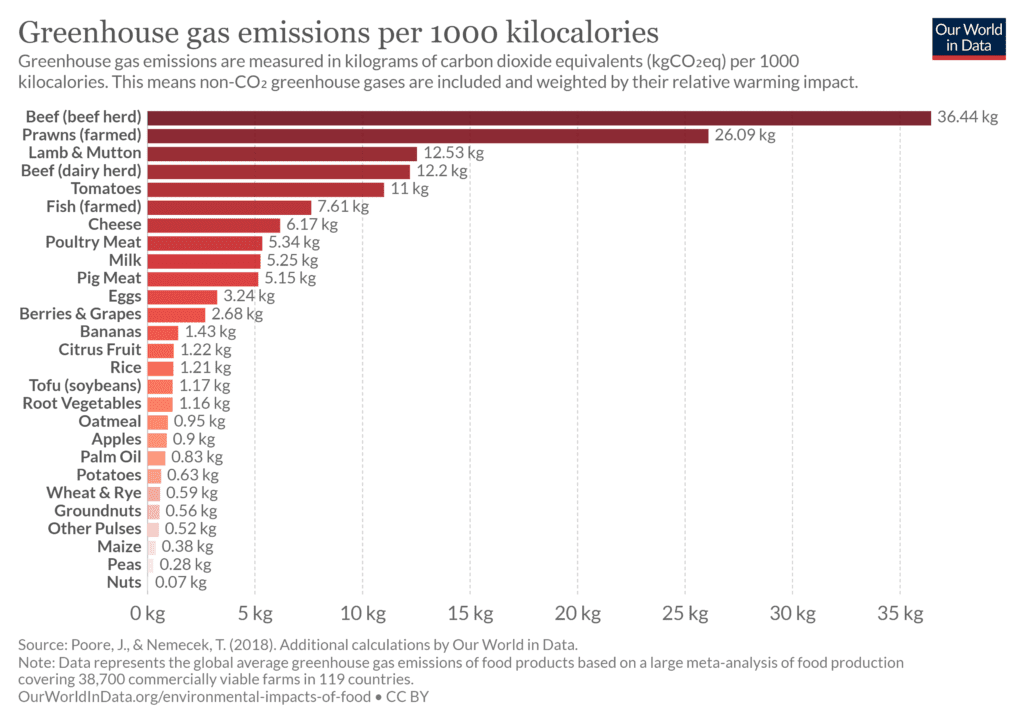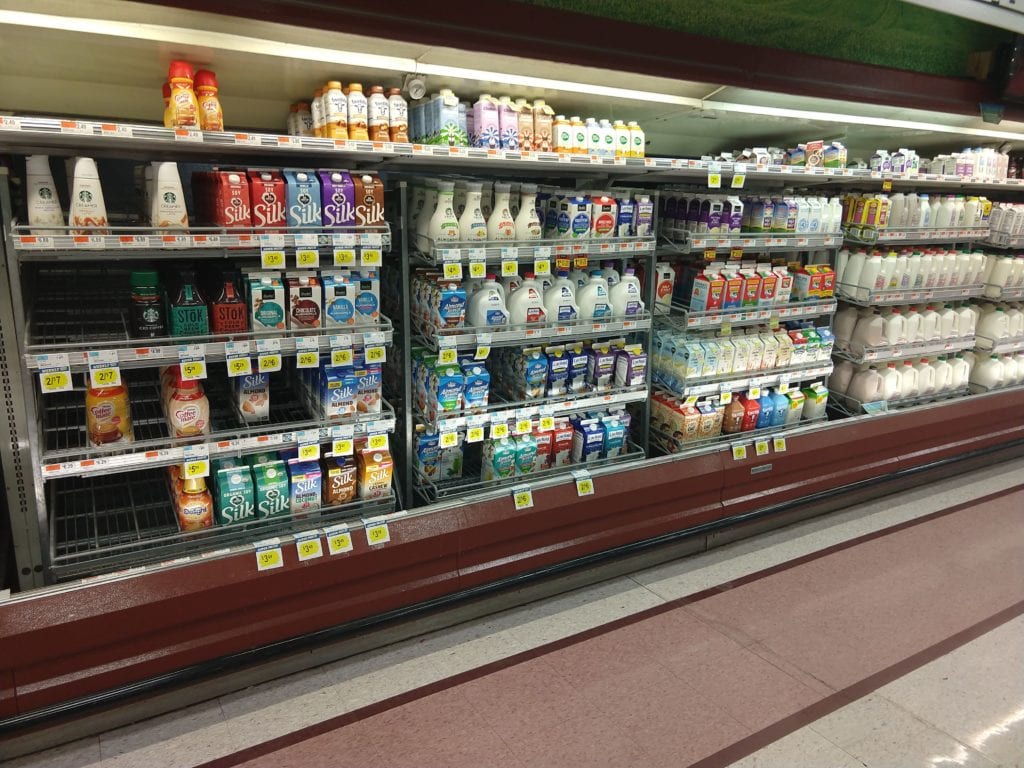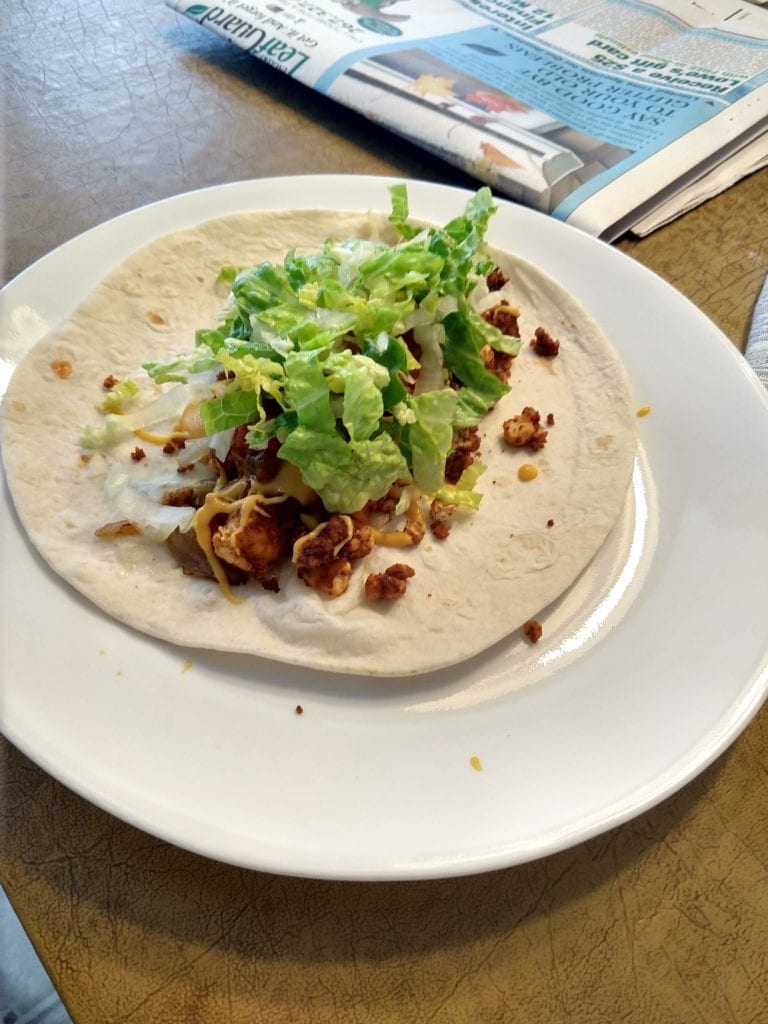It surprised me when I first learned that for many people, one of the most significant ways to reduce our individual carbon footprint is to eat less meat and dairy products. Our carbon footprints include all of the things we use or activities we do that generate greenhouse gas emissions – heating and lighting our homes, manufacturing and transporting our clothes, powering our cars, and producing our food. While I knew that turning out the lights or walking instead of driving could reduce my carbon footprint, it wasn’t until a few years ago that I learned about the environmental consequences of extensive animal agriculture. In addition to the feed, water, and land that raising animals requires, the animals themselves (particularly ruminants like cows and sheep) produce methane as a byproduct of digestion. Methane is a greenhouse gas that, ton for ton, raises the temperature of Earth significantly more than carbon dioxide. According to the United Nations’ Food and Agriculture Organization, livestock generate about 14.5% of total global greenhouse gas emissions.

In terms of greenhouse gas emissions, some foods are more “efficient fuels” for people than others. Producing 1000 calories of beef, for example, generates far more greenhouse gases than 1000 calories of chicken or tofu.
Before learning this information, I ate a pretty average American diet – at least one serving of meat (beef, pork, or poultry) a day in addition to multiple servings of dairy. At dinner, the main portion of my meal was typically some type of meat, with vegetables or starches as sides. Since then, I have sometimes experimented with eating a more plant-based diet ranging from entirely vegetarian to setting aside one day a week for vegetarian meals, and, honestly, sometimes, including recently, have fallen back on my typical meat-reliant diet out of habit. However, when I think about it, it really is more out of habit rather than any preference for eating meat or dairy 7 out of 7 days a week. Knowing this, and knowing the many reasons that people eat plant-based, including environmental benefits, animal welfare, human health, and even reduced food costs, I decided to examine what it might look like for me to replace some or all of the meat, dairy, and eggs I usually consume with plant-based options.
I picked a good time to venture more into the work of vegetarian or vegan foods, as there are a seemingly ever-growing number of options. Almond, cashew, soy, coconut, and oak milks take up nearly as much space as dairy products on the shelves in my grocery store, and recently more stores have started carrying a variety of plant based “meat” products. Even fast food chains have joined in, offering plant-based burgers such as the Impossible Whopper. Online recipes for recreating favorite meals without meat and dairy abound. I took this as one approach – mimicking a conventional diet with foods that aim to replace and taste similar to meat and dairy products. For example, I had cereal with milk on both a plant-based day and a “normal” day, but switched out cow’s milk with soy milk. A second approach was rethinking my diet to put vegetables, fruits, and grains front and center. This meant cooking different recipes, like greens and cannellini beans over pasta instead of meatballs. The vegetarian option was not supposed to recreate the flavor or texture of meatballs, but instead provided protein and other nutrients in an entirely different form.
I used both of these approaches to model 2 days of eating – one with what I might eat on a regular basis, and one where I ate entirely plant-based*. In comparing the two, I focused on aspects that I think many people have questions about when they think about not eating meat or dairy – nutrition (where do you get protein and other nutrients?), convenience, taste, and cost.
*Note: I chose to focus on whether meat, dairy, and eggs products were listed in the ingredients list of the foods I ate. Some of what I ate might not fit every definition of vegan – for example, some vegans do not eat white sugar.
| Meal | Typical Diet | Plant-Based |
| Breakfast | Cereal with milk, peanut butter toast | Cereal with soy milk, peanut butter toast |
| Lunch | Chicken and rice soup with a roll | Tofu tacos with some tortilla chips |
| Dinner | Pasta with meatballs and tomato sauce, salad | Pasta with broccoli rabe and cannellini beans, applesauce |
| Dessert | Cookies and cream ice cream | Black bean brownie |
| Snacks | Apple with peanut butter, Thin Mint cookies, cheese pretzel crackers, a clementine | Apple with peanut butter, trail mix, Thin Mint cookies, popcorn with olive oil and salt, a clementine |
| TOTAL NUTRITION | 24.2g fiber, 76.4g protein, 27mg iron, 690mg calcium | 32.3g fiber, 57.7g protein, 26.55mg iron, 890mg calcium |
| Recommended daily values for me: 25g fiber, 47g protein, 18mg iron, 1,000mg calcium | ||
My first realization, which you might notice looking at my menu for each day, is that a solid portion of what I ate normally did not have to change. Most of my snacks were already dairy- and meat-free, and for breakfast I just had to switch out cow’s milk for soy milk. In a previous Learn by Doing where I focused on eating locally, I had to be conscious of and change just about every item of food I ate throughout the day. For this article, it was helpful to know that it was just a few aspects of my diet that would be affected. For lunch, I wanted to see how much I could mimic something I normally enjoy – tacos – with plant-based ingredients. I had made tofu tacos before and really liked them, but for an added challenge I looked for recipes for vegan cheese sauce too. Many of the ones I saw used coconut milk or cashews (often added to

I made a vegan cheese sauce that used carrots and potatoes as a base with nutritional yeast for a cheesy flavor.
make vegan foods creamy), which I didn’t have, but then I found one with a base of pureed carrots and potatoes. I replaced my afternoon snack of cheese pretzels with popcorn, which is something I would have eaten normally. Later, for dinner, I chose to stick with pasta but make it more hearty with vegetarian toppings rather than meatballs (I have also made vegetarian meatballs in the past using chickpeas, which would be another option). White beans and broccoli rabe were the stars of the dish (you can replace the chicken broth with vegetable broth in the linked recipe), which also had garlic, olive oil, and red pepper flakes. Lastly, for something sweet, I included black bean brownies rather than the ice cream I might normally have. Again, there were many other options I could have chosen, including dairy-free ice creams offered by brands like Ben & Jerry’s or Haagen-Dazs at many grocery stores.
Results
Nutrition
I used this USDA Calculator to get daily nutrient recommendations given my age, gender, height and weight, and activity level. I calculated totals for some key nutrients that people worry will be difficult to get without animal products – protein, iron, and calcium – as well as fiber, which can help with feeling full for longer, another aspect people might think is difficult to achieve while eating plant-based. I found that at least for this one example of my typical diet, I was not getting enough fiber or calcium, but was meeting the recommended amounts of protein and iron. For my plant-based diet, my fiber increased to within the recommended amount, my calcium increased to much closer to the recommended amount, and my iron intake remained similar. My protein amount did decrease, but was still above the minimum recommended amount, even without me focusing on choosing foods with high levels of protein throughout the day. Overall, eating plant-based led to me focusing more on vegetables and ways of integrating them into my diet, which led to a better balance of fiber and protein for me. Of course, foods aren’t necessarily healthy just because they are plant-based, and it’s important to do your research and talk to a health professional to make sure you are getting the nutrients that are right for you.
Convenience
Generally, cooking plant-based meals was no more inconvenient than cooking my typical meals. My regular grocery store carries the ingredients I needed and the recipes did not take longer or involve more steps. One exception is the cheese sauce, which was more time consuming than just melting shredded cheese on tacos or buying cheese sauce at the store. However, that was more of a novelty thing to try, and not something that would need to be made on a regular basis. I think someone trying new plant-based meals could expect to invest a little more time at first to make recipes they are unfamiliar with, but that’s no different than trying new recipes that use meat and dairy.
Taste
I personally both love to try new foods and have some existing favorites that I really enjoy, and I thought that eating plant-based allowed me to have both. It encouraged me to find new recipes with different flavors than I was used to (i.e. broccoli rabe and beans with pasta rather than tomato sauce), and there were options for me to recreate options I normally eat (i.e. tacos and brownies). There are certainly some plant-based foods, like soy milk, that don’t perfectly recreate the taste of their dairy/meat-based counterparts. However, that’s not what everyone wants from them. Soy milk tastes different than normal milk, but I like both. There are so many recipes and options out there that there’s no reason you would have to eat a particular food you don’t like in order to eat plant-based.
Cost
It has been well-documented that as incomes rise, people consume more meat. Generally, meat is more expensive than vegetables, legumes, and grains. However, does this hold true if you’re buying products like plant-based milks or Beyond Meat/Impossible Burgers? It depends, but you can probably expect these plant-based products to be somewhat more expensive than dairy milk or beef, at least the typical store brands. At my grocery store, soy milk was on sale for the same price as dairy milk, but frozen Beyond Beef was at least twice the price of regular ground beef. However, at a restaurant, a veggie burger or vegetarian option is often the same price or slightly less expensive than a meat option.
Conclusions
For me, eating plant-based required less of a dramatic transformation and more of a series of small changes. In doing so, I did not feel that cost or convenience posed major challenges, or that I had to sacrifice flavors or meals that I really enjoy. The most difficult thing was simply that it’s my habit to eat and cook with meat and dairy products, and so eating plant-based required a little more awareness and mental effort. Weighing that against the benefits for the environment, my own health, and animal welfare concerns, the effort to form new habits seems more than worthwhile.
Will I switch to an entirely plant-based diet after this experience? I’m not sure. But I certainly will be more conscious of when I choose to eat meat and dairy, rather than taking it for granted and doing it out of habit. There are a wide range of diets between what the average American eats and an entirely plant-based lifestyle. Rather than eating a certain way just because it’s what I’ve always done, I enjoyed thinking about what the right balance was for me in terms of my taste preferences, the effect I want to have on the environment, and the local food options available to me. By eating meat and dairy less often, I will be more focused on choosing local, more sustainably produced animal products, like pasture-raised beef or free-range chicken from a nearby farm. Another idea I read about that I’m interested in trying is something used in an initiative among food service and culinary professionals called “Plant-Forward.” They move meat from the center of the plate to the edges in smaller portions and increase the focus on vegetables. Similarly, they might make a burger that mixes mushrooms with beef, so meat is still part of the meal, but in a reduced amount with some of it replaced by plants. The idea is that if everyone ate just 5% less meat while still having it as frequently as they normally do, it would have the same effect as 5% of people completely cutting out meat.
Ultimately, I found that eating plant-based was largely beneficial with few to no personal downsides for me. Therefore, I will be looking to reduce most of my meat and dairy consumption moving forward. However, for other people, there may be a strong attachment to eating meat, the idea of finding new plant-based recipes might be daunting, or other obstacles may exist to making a complete change to plant-based eating. If this is the case for you, it could be helpful to keep in mind that you don’t have to take an all-or-nothing approach. Even just changing a few meals a week to use a smaller portion of meat and more vegetables would be more beneficial than the status quo. “Meatless Mondays” have become another popular idea in recent years, where people commit to eating plant-based meals for one day a week. If you often go out to lunch, you might consider trying a restaurant with plant-based options like Greentruth Plant-Based Kitchen in Easton or VegOut in Bethlehem. Considering whether a more plant-based diet in any form might work for you is a great way to ensure that you’re eating a particular way because you want to be eating that way, not just because it’s a habit or how most people eat. The ideal diet will look different for everyone, but for people who eat as much meat and dairy as many Americans, there’s a good chance that reducing reliance on animal products and consuming more plants could come with many benefits, both individual and environmental!


